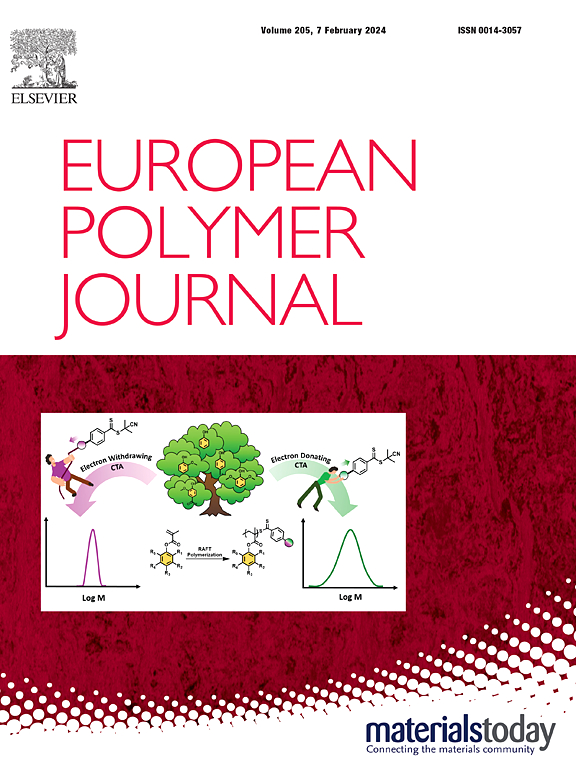The pivotal influence of water on the epoxide ring-opening polymerization by tertiary amines
IF 5.8
2区 化学
Q1 POLYMER SCIENCE
引用次数: 0
Abstract
An interfacial synthesis route was recently established to prepare epoxide-based membranes for water purification. Herein, the epoxide is dissolved in toluene and reacts with a tertiary amine dissolved in water. However, to date the exact mechanism of the polyether film formation at the water/organic interface is poorly understood. The aim of this work was to bridge the gap between membrane engineering and polymer chemistry by investigating the influence of water on the ring-opening polymerization of a model epoxide monomer, phenyl glycidyl ether (PhGE), by four tertiary amine initiators (i.e., N,N-dimethyl hexylamine, imidazole, 1-methyl imidazole, and N,N,N’,N’-tetramethyl hexane diamine). This was done in a homogenous system in toluene, i.e. via solution polymerization, as well as in a heterogenous toluene/water system, i.e., via interfacial polymerization. The pseudo-first order plots of the homogenous system showed long induction periods and slow reaction rates. Surprisingly, a strong catalytic effect of trace amounts of water was observed, as demonstrated by the significant increase in reaction rate (up to 28 times) and a decrease in the induction period (by 10 days), which occurred upon the addition of water. Characterization of the synthesized polymers with ESI-MS indicated successful initiation by all tested tertiary amines, but side reactions also occurred. In addition, polyether formation was successful in the studied interfacial system. The achievable molar mass and the species that initiated the reaction (i.e., amine, PhGE, water/hydroxide) depended both on the amine:epoxide ratio and the pH. Observed discrepancies between the homogeneous and heterogeneous system appear to be largely influenced by the properties of the amine initiator.

水对叔胺开环聚合环氧化物的关键影响
最近建立了一种界面合成路线来制备环氧化物基水净化膜。在此,环氧化物溶解在甲苯中并与溶解在水中的叔胺反应。然而,迄今为止,人们对水/有机界面聚醚膜形成的确切机制知之甚少。这项工作的目的是通过研究水对四种叔胺引发剂(即N,N-二甲基己胺,咪唑,1-甲基咪唑和N,N,N ',N ' -四甲基己烷二胺)的模型环氧化物单体苯基甘油醚(PhGE)开环聚合的影响,弥合膜工程和聚合物化学之间的差距。在甲苯均相体系中,即通过溶液聚合,以及在甲苯/水非均相体系中,即通过界面聚合。均相体系的拟一阶图表现为诱导期长、反应速率慢。令人惊讶的是,微量水的强烈催化作用被观察到,正如在加入水后反应速率显著增加(高达28倍)和诱导期缩短(10天)所证明的那样。用ESI-MS对合成的聚合物进行表征,结果表明所有的叔胺都能成功引发,但也发生了副反应。此外,聚醚的形成在所研究的界面体系中是成功的。可达到的摩尔质量和引发反应的物质(即胺、PhGE、水/氢氧化物)取决于胺:环氧化物的比例和ph值。观察到的均相和非均相体系之间的差异似乎在很大程度上受到胺引发剂性质的影响。
本文章由计算机程序翻译,如有差异,请以英文原文为准。
求助全文
约1分钟内获得全文
求助全文
来源期刊

European Polymer Journal
化学-高分子科学
CiteScore
9.90
自引率
10.00%
发文量
691
审稿时长
23 days
期刊介绍:
European Polymer Journal is dedicated to publishing work on fundamental and applied polymer chemistry and macromolecular materials. The journal covers all aspects of polymer synthesis, including polymerization mechanisms and chemical functional transformations, with a focus on novel polymers and the relationships between molecular structure and polymer properties. In addition, we welcome submissions on bio-based or renewable polymers, stimuli-responsive systems and polymer bio-hybrids. European Polymer Journal also publishes research on the biomedical application of polymers, including drug delivery and regenerative medicine. The main scope is covered but not limited to the following core research areas:
Polymer synthesis and functionalization
• Novel synthetic routes for polymerization, functional modification, controlled/living polymerization and precision polymers.
Stimuli-responsive polymers
• Including shape memory and self-healing polymers.
Supramolecular polymers and self-assembly
• Molecular recognition and higher order polymer structures.
Renewable and sustainable polymers
• Bio-based, biodegradable and anti-microbial polymers and polymeric bio-nanocomposites.
Polymers at interfaces and surfaces
• Chemistry and engineering of surfaces with biological relevance, including patterning, antifouling polymers and polymers for membrane applications.
Biomedical applications and nanomedicine
• Polymers for regenerative medicine, drug delivery molecular release and gene therapy
The scope of European Polymer Journal no longer includes Polymer Physics.
 求助内容:
求助内容: 应助结果提醒方式:
应助结果提醒方式:


